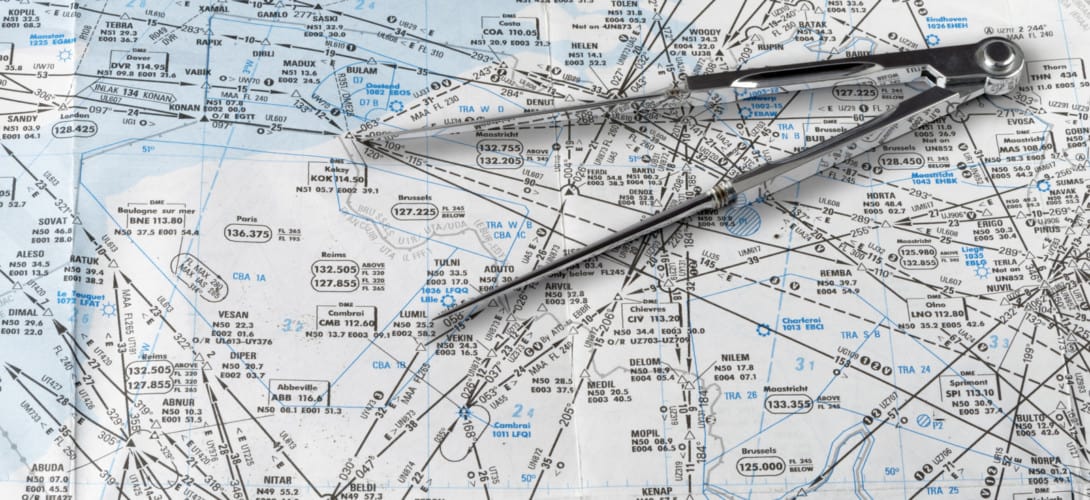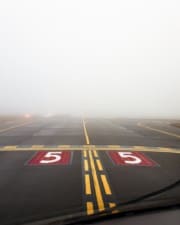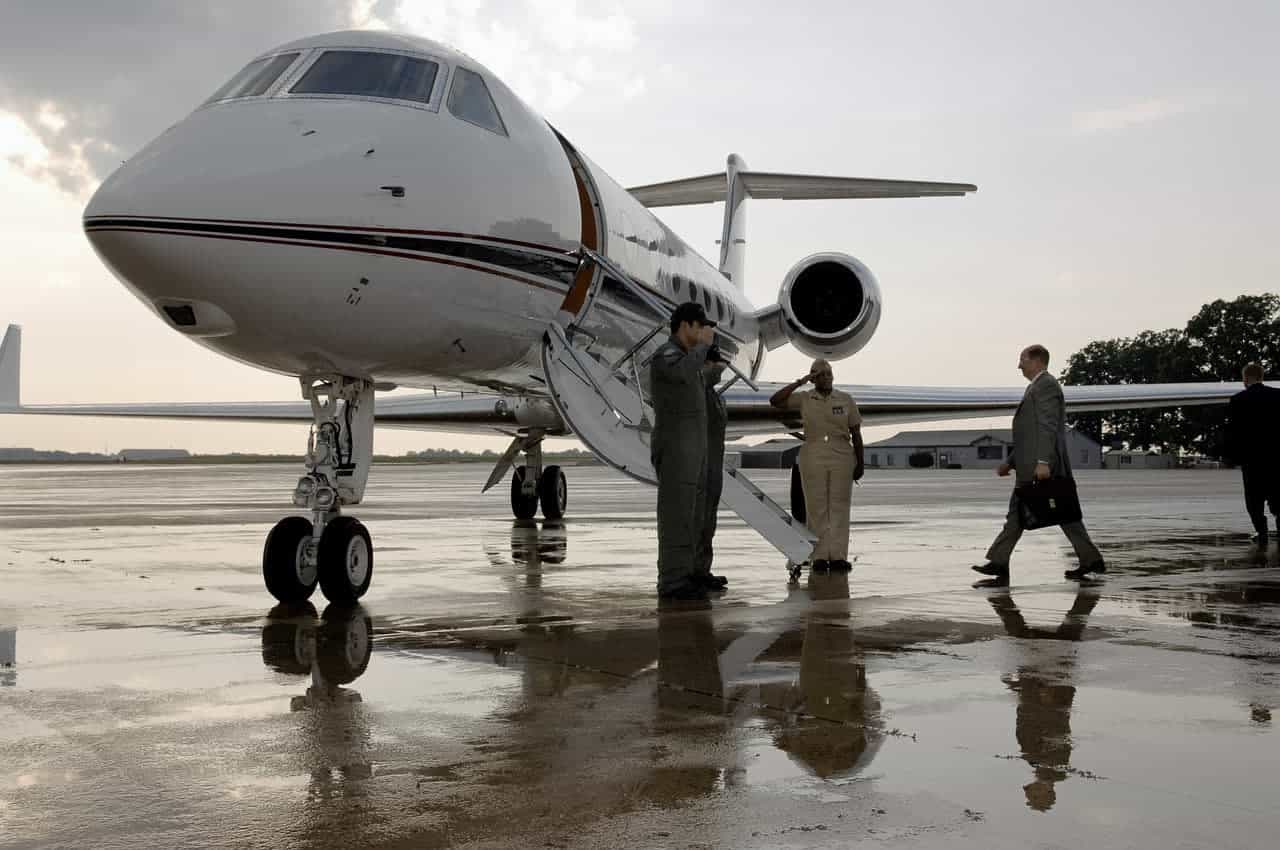Despite the ominous-sounding name, dead reckoning is a fundamental skill that all pilots must learn. It’s been around for hundreds of years and is a basic part of celestial navigation. Pilots and mariners have crossed oceans with nothing more. And while modern pilots seldom learn celestial nav anymore, dead reckoning is a handy skill for every type of pilot to learn.
Dead reckoning is a type of navigation that involves estimating your speed and course over the ground. Then you can estimate your position along your course at any time based simply on how long you have been flying.
Table of Contents
What Does the Term Dead Reckoning Mean?
First, what’s with the funny name? The proper term is “deduced reckoning,” but this is a bit of a mouthful. Some believe this was shortened to ded reckoning, which later morphed into “dead.”
Dead reckoning was (or is, depending on your hobbies and professions) an important part of celestial navigation. In celestial, “live navigation” is taking sights and making accurate fixes using the stars, planets, or sun. “Dead,” on the other hand, is when you only have your compass, speed, and course to make estimates between sights.
Finally, some believe that the term refers to the accuracy of the results, as in “dead right” or “dead on.”
Whatever the precise origins of the term are, it all means the same thing. Dead reckoning is the skill of figuring out where you are using basic direction, time, speed, and distance calculations.
All pilots are trained to use three types of navigation: pilotage, dead reckoning, and electronic. Pilots use all three types of navigation every day, whether they realize it or not. And all three are required tasks on the Private Pilot checkride.
What is Pilotage in Aviation?
The most basic form of air navigation is called pilotage. In its most basic form, it means that the pilot looks out the window.
There’s an old pilot’s joke about flying everywhere “IFR–I Follow Roads.” It’s a fun pun when talking to an instrument-rated IFR pilot, but there is truth in this joke. Following roads is a great example of pilotage. If you want to navigate from Fort Lauderdale to Naples, Florida, and you know that Interstate I-75 connects the two, then why can’t you fly along I-75?
The same trick works for coastlines or rivers, power lines or railroad tracks. These things are easily visible from the air and shown on aeronautical charts. A pilot can follow a straight line to where they’re going or navigate from one landmark to another along the way.
Pilotage is basic and easy, but it does have a few disadvantages. For one, if the visibility is low, it could become easy to get disoriented. Another problem is that it doesn’t provide the pilot with any information like how long it will take to get to their destination and do they have enough fuel left to make it there?
Dead Reckoning in Aviation
Dead reckoning is one step up from pilotage; it adds another level of formality. With dead reckoning, a pilot has a little help finding objects in low visibility or when they can’t see from one landmark to the next.
Dead reckoning also involves a little bit of math. By figuring out the plane’s speed and course over the ground, the pilot can determine where they are based on how long they’ve been flying. Or, in other words, they’ll know where they’ll be in 15 minutes, 30 minutes, or an hour.
This extra work has even more benefits, though. If a pilot knows how long each leg of the flight takes, then they know how long the entire trip will take. And that means they can complete the most important thing of all–fuel planning.
Dead reckoning answers questions like, how long will it take to get to my destination and how much fuel will I use to get there?
Charles Lindberg used dead reckoning to fly from the US to Paris, France, in 1927. Think about that the next time you’re in an airplane cockpit because it’s pretty amazing.
Radio Navigation
Both pilotage and dead reckoning rely on the pilot using visible landmarks on the ground to navigate. We all know that airplanes navigate through fog and haze daily without any issues. They do it by using radio or electronic navigation.
This broad term describes navigating from Point A to Point B using signals from outside the aircraft. Many technologies are used to achieve this feat, but today the most prominent are VOR and GPS.
VORs (Very-high frequency Omnidirectional Ranges) use a system of ground-based stations that are all shown on aeronautical charts. A VHF NAV radio in the cockpit interprets the signal and provides the direction from the station of the plane’s location. Even though they are an old technology, VORs are still the backbone of the US air navigation system.
GPS is familiar to everyone nowadays since we have GPS receivers in our smartphones and cars. In aviation, GPS provides accurate satellite-based navigation nearly anywhere on earth.

Explaining Dead Reckoning
Dead reckoning isn’t very complicated, but getting it right takes a little practice. And despite its common use in aviation, dead reckoning is much older than the airplane. Seafarers have been using dead reckoning–with an almost identical technique–for hundreds of years.
In the simplest terms, dead reckoning is using a chart to measure the distance and direction between two points and then using your speed to calculate how long it will take to fly there.
Advantages of Dead Reckoning
- Can be done with no assistance from ground stations
- Requires only a chart, plotter, and flight computer
- Can be done before the flight or in the air
- A fundamental navigation skill–still used in programmed systems like inertial navigation systems (INS) and automotive GPS
- The ultimate backup technology
Disadvantages of Dead Reckoning
- Based on approximations and estimated values
- Seldom 100% accurate
- A time-consuming process to complete
- Subject to cumulative errors–a small error becomes a bigger and bigger problem the longer you fly
How to Do Dead Reckoning Flight Planning
Dead reckoning starts with a line drawn on the chart from Point A to Point B. Using the chart, you can get the course and distance between the two points. Next, from the weather, you should have a solid idea of what the winds aloft will be doing to you. Finally, from your airplane’s Pilot’s Operating Handbook, you will know what your true airspeed (TAS) and fuel burn will be (GPH).
With all of these data points, you can calculate a few facts. By correcting for the wind’s direction and speed, you can find your compass heading and ground speed. Once you know your ground speed, you can figure out how long the leg will take you using the dead reckoning formula.
Time = Distance / Speed
Once you know how long the leg will take, you can find how much fuel you’ll use by calculating it from your plane’s fuel burn rate in gallons per hour (GPH).
Even when you complete it carefully, dead reckoning is never more than an educated guess. The winds aloft forecast isn’t perfect, and you might have been a degree or two off when you measured your course. This is why it’s vitally important that you update your flight plan as you fly. By checking your work as you go, your numbers will get progressively more accurate the longer you fly.
How To Use Dead Reckoning on a Typical Flight
So that’s the big picture of how you do dead reckoning, but how do you use it on the typical flight?
Dead reckoning is how you perform a VFR (visual flight rules) cross-country. Before you set out on the flight, you sit in a planning room with your charts and tools and figure out the exact course you will fly. In doing the steps outlined above, you’ll know how long the trip will take and how much fuel you need to have on board. All the details are recorded on a flight planning log sheet that you will update as you fly in the plane.
Having the plan completed in advance is key. There is not enough time to do it in the air, and spreading out the chart in your lap is awkward. Getting accurate courses and distances is tough, too. You can do dead reckoning in the cockpit, but the best calculations come from preflight planning.
Dead reckoning keeps you safe. It forces you to analyze the charts carefully, looking for restricted airspace or hazards along your route. It keeps your mind active during the flight, always looking for the next waypoint and calculating new ETAs. As a result, the pilot doing this work is unlikely to find themselves lost or disoriented.
Once you move to instrument (IFR) flying, dead reckoning might seem like a skill of the past. But dead reckoning is fundamental to every type of air navigation. For example, you cannot set out on an IFR flight without knowing your fuel use and estimated time en route. The skills needed to figure these things out, come from basic dead reckoning.
GPS computers can answer a lot of these questions for the pilot. But pilots need to be ready to get themselves to safety in the event of an equipment failure. While the GPS satellite system is incredibly reliable and unlikely to fail, the same cannot be said for small aircraft alternators. What if the plane is struck by lightning, and you lose all of your electronics? Or what if your receiver suddenly loses its signal one day in an unfamiliar area?
Dead reckoning is every pilot’s “Get Out of Jail Free” card. So long as the pilot can look out the window, hold a sectional chart, and have a rough idea of where they started, they should be able to navigate pretty much anywhere and never be lost.
References ▾
Related Posts

















